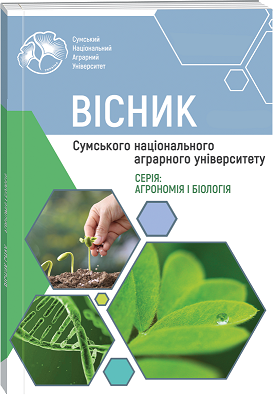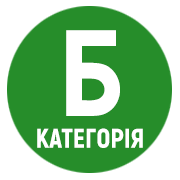THE DYNAMICS REFLECTING THE NUMBER OF WINTER WHEAT PESTS IN THE CONDITIONS OF SUMY REGION
Abstract
The research was conducted in the basic husbandries of the phytosanitary safety department of the main department of the State Food and Consumer Service in Sumy region in 2016–2018. The method of the research was general. Winter wheat crops damages are caused by scarab beetle (Anisoplia austriaca Hrbst.), cereal chafer (Anisoplia segetum Hrbst.), oat leaf beetle (Oulema melanopus L.), blue cereal leaf beetle (Oulema lichenis Voet.), barley flea beetle (Phyllotreta vittula Redt.), corn ground beetle (Zabrus tenebrioides Goeze), Bishop's Mitre (Aelia acuminata L.), sunn pest (Eurygaster integriceps Put.), wheat aphid (Schizaphis graminum Rond.), wheat thrips (Haplothrips tritici Kurd.), Hessian fly (Mayetiola destructor Say), frit fly (Oscinella pusilla Mg.). The scarab beetle is widespread in the Sumy region, and the cereal chafer is more common in the Polissya region. Bread beetle larvae inhabited 22.7 % of winter wheat areas in 2016, 20.3 % in 2017, and 23,9 % in 2018. The average number of larvae of bread beetles in 2016, 2018 was 0,7 specimens per m2, in 2017 – 0,9 specimens per m2. The most common in wheat crops were adults of bread beetles, which in the phase of milk-wax ripeness gnawed the grain and pushed the grain out of the ear. Bread beetles in the phase of milk ripeness of grain inhabited in 2016 85,2% of the surveyed areas of winter wheat, in 2017 – 84,6 %, in 2018 – 72.4 %. The number of adult grain beetles was 0,3 specimens per m2 in 2016, in 2017 – 0.4 specimens per m2, in 2018 – 0.6 specimens per m2. Due to feeding on the grain of larvae and bugs, winged eels of the Bishop's Mitre and sunn pest, the baking and nutritional qualities of flour, as well as sowing qualities of grain deteriorate. Bread bugs inhabited 24,1% of surveyed areas of winter wheat in 2016, 37.1 % in 2017, and 42.3 % in 2018. The average number of bread bugs on winter wheat crops was 0,7 specimens per m2. In 2016–2017, the number of larvae of the frit fly in the autumn was 1.4 specimens per m2, and in 2018 increased to 2.0 specimens per m2. The number of larvae of the Hessian fly in 2016–2017 was 1.3 specimens per m2, in 2018 – 1.5 specimens per m2.
References
2. Borzyh, O. I., & Krut', M. V. (2019). Baza danyh innovacijnyh rozrobok iz zahystu zernovyh kul'tur v Ukrai'ni [Database of innovative developments in the protection of grain crops in Ukraine]. Zahyst i karantyn roslyn, 65, 3–16. doi: 10.36495/1606-9773.2019.65.3-16 (in Ukrainian).
3. Borzih, O. І., & Fedorenko, V. P. (2016). Suchasnі problemi fіtosanіtarnogo stanu agrocenozіv v Ukraїnі [Modern problems of phytosanitary condition of agrocenoses in Ukraine]. Zahist і karantin roslin, 62, 3–17 (in Ukrainian).
4. Golіnach, O. L., Vlasenko, V. A., Demenko, V. M., Hіl'ko, N. V., Proshhenko, O. V., & Tkachenko, V. A. (2021). Prognoz fіtosanіtarnogo stanu agrocenozіv ta rekomendacії shhodo zahistu kul'turnih roslin vіd shkіdnikіv, hvorob ta bur’janіv u gospodarstvah Sums'koї oblastі v 2021 rocі. [Forecast of phytosanitary condition of agrocenoses and recommendations for protection of cultivated plants from pests, diseases and weeds in farms of Sumy region in 2021]. Golovne upravlіnnja Derzhprodspozhivsluzhbi u Sums'kіj oblastі. Sumi, 117 (in Ukrainian).
5. Demenko, V. M., Govorun, O. L., Vlasenko, V. A., Jemec', O. M., & Hil'ko, N. V. (2016). Dynamika chysel'nosti osnovnyh shkidnykiv zernovyh kul'tur v umovah pivnichno-shidnogo Lisostepu Ukrai'ny. [Dynamics of the number of the main pests of grain crops in the conditions of the North-Eastern Forest-Steppe of Ukraine]. Visnyk Sums'kogo NAU. Serija «Agronomija i biologija». 2(31), 50–55 (in Ukrainian).
6. Demidov, O. A., & Muha, T. І. (2019). Kontrol' chisel'nostі hlіbnih klopіv u agrocenozі pshenicі. [Control of the number of bedbugs in the wheat agrocenosis] Propozicіja: Іnformacіjnij shhomіsjachnik. Ukraїns'kij zhurnal z pitan' agrobіznesu. TOV "Kompanіja "Junіvest Marketing", Kiїv, 6, 102–104 (in Ukrainian)..
7. Dolja, M. M., Pokozij, J. T., Mamchur, R. M., Dolja, L. I., Mel'nyk, B. V., Dmytrijeva, O. Je., Homenko, I. I., Bondarjeva, L. M., & Gumenjuk, L. V. (2004). Fitosanitarnyj monitoring. [Phytosanitary monitoring]: posibnyk dlja stud. agron. spec. vyshh. zakl. / za red. M. M. Doli ta J. T. Pokozija. K.: DOD NNC «Instytut agrarnoi' ekonomiky», 291 (in Ukrainian).
8. Kornіjchuk, M. S. (2019). Fіtosanіtarnij stan agrocenozіv v umovah zmіni klіmatu ta shljahi jogo pokrashhannja. Zemlerobstvo. [Phytosanitary condition of agrocenoses in the conditions of climate change and ways of its improvement], 2(97), 45–57 (in Ukrainian).
9. Kosylovych, G., & Goljachuk, Ju. (2019). Zahyst pshenyci ozymoi' vid shkidnykiv i hvorob. [Protection of winter wheat from pests and diseases]. Visnyk L'vivs'kogo NAU. Serija «Agronomija», 23, 159–163 (in Ukrainian).
10. Krut', M. V. (2021) Іnnovacії z prognozuvannja fіtosanіtarnogo stanu agrocenozіv. [Innovations for forecasting the phytosanitary condition of agrocenoses]. Ricerche scientifiche e metodi della loro realizzazione: esperienza mondiale e realta domestiche: Raccolta di articoli scientifici «ΛΌGOΣ» con gli atti della I Conferenza scientifica e pratica internazionale (T. 1), Bologna, May 14, Bologna-Vinnytsia: Associazione Italiana di Storia Urbana & Piattaforma scientifica europea, 91–95. doi: 10.36074/logos-14.05.2021.v1.28 (in Italiana).
11. Krut', M. V., & Gavriljuk, L. L. (2020). Baza danih іnnovacіjnih rozrobok іz zahistu zernovih kul'tur v Ukraїnі. [Database of innovative developments in the protection of grain crops in Ukraine]. The 10th International scientific and practical conference “Topical issues of the development of modern science” (June 4-6, 2020) Publishing House “ACCENT”, Sofia, 384–389 (in Bulgarian).
12. Kuz'menko, N. V., Popov, S. I., Lytvynov, A.Je., Popova, K. M., Glubokyj, O. M., Malahov, D. Ju., & Olejnikov Je. S. (2016). Systema zahystu zernovyh kolosovyh kul'tur vid hvorob ta shkidnykiv v umovah shidnoi' chastyny Lisostepu Ukrai'ny.
[The system of protection of cereals from diseases and pests in the eastern part of the Forest-Steppe of Ukraine]. NAAN, In-t roslynnyctva im. V. Ja. Jur’jeva NAAN, Charkiv, 24 (in Ukrainian).
13. Medvіd', V. S. (2020). Entomofauna pshenicі ozimoї u Pravoberezhnomu Lіsostepu Ukraїni. [Entomofauna of winter wheat in the Right-Bank Forest-Steppe of Ukraine]. Vіsnik agrarnoї nauki Prichornomor’ja, 3, 96–104 (in Ukrainian). doi: 1 0.31521/2313-092X/2020-3(107) -12
14. Mostov’jak, І. І, Dem’janjuk, O. S., Lіsovij, M. M. (2020). Ekologіchna struktura shkіdlivogo entomokompleksu agrocenozіv zernovih zlakovih kul'tur Central'nogo Lіsostepu Ukraїni. [Ecological structure of the harmful entomocomplex of agrocenoses of grain cereals of the Central Forest-Steppe of Ukraine]. Agroekologіchnij zhurnal. 2. 31-39. DOI: https://doi.org/10.33730/2077-4893.2.2020.207678 (in Ukrainian).
15. Osinnij zahyst dlja pshenyci. [Autumn protection for wheat]. (2020). Agrobiznes s'ogodni. 4 veresnja. URL: http://agro-business.com.ua/agro/ahronomiia-sohodni/item/18693 (in Ukrainian).
16. Perelik pestycydiv i agrohimikativ, dozvolenyh do vykorystannja v Ukrai'ni. [List of pesticides and agrochemicals approved for use in Ukraine] (2018). JuNIVEST MEDIA, K., 1039 (in Ukrainian).
17. Pisarenko, P. V., Matjuha, V. L., Pisarenko, P. P., & Antonenko, Ja. V. (2021). Efektivnіst' bakovih sumіshej pesticidіv proti shkіdnikіv ta hvorob u tehnologії viroshhuvannja pshenicі ozimoї v Pіvnіchnomu Stepu Ukraїni. [Efficiency of tank mixtures of pesticides against pests and diseases in the technology of growing winter wheat in the Northern Steppe of Ukraine]. Vіsnik PDAA, 1, 80–89 (in Ukrainian). doi: 10.31210/visnyk2021.01.09
18. Pristac'ka, O. N., Bіlovus, G. Ja., & Vashhishin, O. A. (2021). Vpliv abіotichnih faktorіv ta okremih elementіv tehnologії na shhіl'nіst' populjacіj fіtofagіv u posіvah pshenicі ozimoї v Zahіdnomu Lіsostepu Ukraїni. [Influence of abiotic factors and separate elements of technology on the density of phytophagous populations in winter wheat crops in the Western Forest-Steppe of Ukraine]. Peredgіrne ta gіrs'ke zemlerobstvo і tvarinnictvo, 69(2), 91–107 (in Ukrainian). doi: 10.32636/01308521.2021-(69)-2-6
19. Sahnenko, V. V., & Sahnenko, D. V. (2018). Osoblyvosti rozmnozhennja shkidnykiv pshenyci ozymoi' pry resursooshhadnyh systemah zastosuvannja dobryv u Lisostepu Ukrai'ny. [Peculiarities of reproduction of winter wheat pests in resource-saving systems of fertilizer application in the Forest-Steppe of Ukraine]. Visnyk Poltavs'koi' DAA. 3. 45–49 (in Ukrainian).
20. Sahnenko, V. V., & Sahnenko, D. V. (2020) Obґruntuvannja bіologіchnih і hіmіchnih zahodіv shhodo kontrolju kompleksu fіtofagіv na pshenicі ozimіj u Lіsostepu Ukraїni. [Substantiation of biological and chemical measures to control the complex of phytophages on winter wheat in the Forest-Steppe of Ukraine] Tavrіjs'kij naukovij vіsnik, 111, 131–136 (in Ukrainian). doi: 10.32851/2226-0099.2020.111.18
21. Sekun, M. P., Vlasova, O. G., & Berezovs'ka-Brigas, V. V. (2019). Monіtoring formuvannja rezistentnostі populjacіj shkіdnikіv sіl's'kogospodars'kih kul'tur do іnsekticidіv. [Monitoring the formation of resistance of crop pest populations to insecticides]. Zahist і karantin roslin, 65, 149–160. doi: 10.36495/1606-9773.2019.65.149-160
22. Strigun, O. O., & Suddenko, Ju. M. (2016). Vidovij sklad shkіdlivoї entomofauni agrobіocenozu pshenicі ozimoї v Pravoberezhnomu Lіsostepu Ukraїni. [Species composition of harmful entomofauna of winter wheat agrobiocenosis in the Right-Bank Forest-Steppe of Ukraine]. Vіsnik Poltavs'koї derzhavnoї agrarnoї akademії. 3, 15–18 (in Ukrainian).
23. Suchasnyj zahyst zernovyh kolosovyh kul'tur vid shkidnykiv. [Modern protection of cereals from pests] (2019). Agronom. 18 bereznja URL: https://www.agronom.com.ua/zahyst-zernovyh-kolosovyh-kultur-vid-shkidnykiv/ 4296 (in Ukrainian).
24. Shkidnyky i hvoroby ozymyh zernovyh: potochna sytuacija. [Pests and diseases of winter cereals: the current situation]. (2019). Propozycija. 16 travnja. URL: https://propozitsiya.com/ua/shkidnyky-i-hvoroby-ozymyh-zernovyhpotochna-sytuaciya/ 4010 (in Ukrainian).
25. Shahova, N. M., & Kocjurubenko, N. I. (2012). Zahyst ozymoi' pshenyci vid sysnyh shkidnykiv. [Protection of winter wheat from sucking pests]. Naukovo-metodychnyj zhurnal «Naukovi praci». Serija «Ekologija». Tom 179. 167. 146–150 (in Ukrainian).
26. Varchenko, T., Dolja, M. M., Nemeric'ka, L., & Zhuravs'ka, І. (2017). Osoblivostі formuvan' shkіdlivih organіzmіv pri resursooshhadnih tehnologіjah zahistu sіl's'kogospodars'kih kul'tur u Lіsostepu і Polіssі Ukraїni. [Peculiarities of pest formation in resource-saving technologies of crop protection protection in the Forest-Steppe and Polissya of Ukraine].
Agrarna nauka ta osvіta Podіllja: zbіrnik naukovih prac' mіzhnar. nauk.-prakt. konf. Ch.1. (14-16 bereznja 2017 r., m. Kam’janec'-Podіl's'kij). Ternopіl' : Krok, 2017, 173–175 (in Ukrainian).
27. Vinnichuk, T. S., Parmins'ka, L. M., & Gavryljuk, N. M. (2016). Zahyst pshenyci ozymoi' vid hvorob ta shkidnykiv za riznyh system udobrennja. [Protection of winter wheat from diseases and pests under various fertilizer systems]. Visnyk agrarnoi' nauky. 9. 30–34 (in Ukrainian).
28. Zahyst ozymoi' pshenyci vid shkidnykiv. [Protection of winter wheat from pests]. (2020). Avgust. 13 travnja. URL: http://ua.avgust.com /zahist_ozimoi_pshenici_vid_shkidnikiv (in Ukrainian).

 ISSN
ISSN  ISSN
ISSN 


